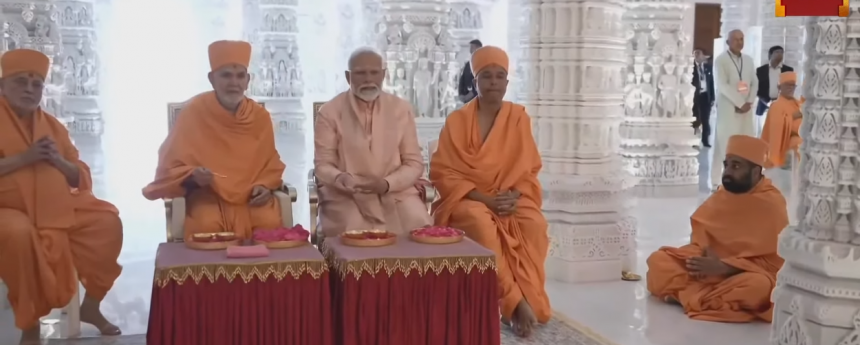Indian Prime Minister Narendra Modi inaugurated Abu Dhabi’s landmark Hindu temple on Wednesday, arriving at the dedication ceremony just after 4:30 pm. Following the inauguration, the temple is scheduled to open to the public from February 18. However, UAE residents have been advised to visit from March 1 due to the expected influx of overseas visitors. A week-long celebration is planned at the temple site from Thursday to the following Wednesday, featuring prayers and discussions on harmony and peace. Visitors interested in attending the harmony week celebrations are required to register on the temple website at www.mandir.ae.
Inauguration ceremony of Abu Dhabi’s landmark Hindu temple, officiated by Indian Prime Minister Narendra Modi, occurred on Wednesday afternoon, with Modi arriving just after 4:30 PM local time. The ceremony was followed by a guided tour of the temple and meetings with senior officials. This event marked a significant moment for inter-faith harmony in the Emirates, as the UAE’s first traditional hand-carved Hindu temple was officially dedicated.

Worshipers and tourists, from within and outside the UAE.
Hindu temple in Abu Dhabi will be open to the public starting from February 18. However, UAE residents have been requested to visit from March 1 due to the anticipated influx of overseas visitors traveling to the Emirates to view the venue.
A week-long celebration at the temple site will commence from Thursday until the following Wednesday, featuring prayers and talks on harmony and peace. Visitors interested in attending the harmony week celebrations are required to register on the temple website at www.mandir.ae.
Celebrations begin
The consecration ceremony to bless the deities and the Hindu temple in Abu Dhabi began on Wednesday morning. Head priests of the BAPS Swaminarayan Sanstha initiated the ceremony at 7:15 am, reciting sacred Sanskrit verses, offering prayers, and presenting flowers.
This approximately three-hour prayer service was conducted as a private ceremony at the temple located in the capital’s Cultural District in the Abu Mureikha area, situated off the highway linking Dubai to Abu Dhabi. Throughout the morning, blessings and Vedic prayers from ancient Indian religious texts were bestowed upon the temple.
Later in the day, the temple was officially inaugurated and dedicated by Indian Prime Minister Narendra Modi.

Seven spires, seven emirates
The construction of the Hindu temple in Abu Dhabi has been a highly anticipated project, featuring magnificent sculptures crafted from pink sandstone and white marble. Sculpting work began in 2020, and the temple’s distinctive design, characterized by seven shikhars or spires, now stands prominently against the UAE desert landscape.
Mahant Swami Maharaj, the spiritual leader of BAPS, described the temple’s emergence as a miracle, likening it to a lotus blossoming in the desert. The seven spires symbolically represent the seven emirates of the UAE, with each section showcasing the life and teachings of deities revered by Hindus across India.
The temple, with a capacity to accommodate between 8,000 to 10,000 people, is open to individuals of all faiths. Upon entering, visitors will encounter two streams of water symbolizing the Ganga and Yamuna rivers in India, while a beam of light represents the river Saraswati.
Before entering the temple, visitors have the opportunity to ring a series of small copper and brass bells. Inside, they can ascend a flight of stairs or utilize concealed elevators to reach the first level for prayers before the deities.
Elaborate carvings adorn the temple, depicting age-old stories such as the celebrations in the ancient town of Ayodhya to welcome home the Hindu God Rama. The outer walls of the temple showcase carvings narrating the stories of various deities, providing visitors with a visual journey through Hindu mythology and culture.
Mr. Desai, a representative involved in the project, expressed the awe-inspiring beauty of the temple, describing it as if built upon the confluence of three holy rivers – Ganga, Yamuna, and Saraswati. The intricate carvings and storytelling elements within the temple create a captivating experience for visitors, bringing to life the cherished tales of their childhood in a tangible form.

Architectural wonder
The Hindu temple in Abu Dhabi stands as an architectural marvel, crafted by the skilled hands of over 2,000 artisans from India’s Rajasthan and Gujarat states over the past three years. These artisans meticulously carved 402 white marble pillars, each bearing unique stories from Indian scriptures and adorned with over 1,000 statues representing deities and spiritual gurus. The level of detail in each pillar is such that it can take a team of four artisans at least a year to complete a single pillar.
The temple’s exquisite sculptures, depicting peacocks, elephants, horses, camels, phases of the moon, and musicians playing traditional instruments, showcase the artisans’ exceptional craftsmanship. One particularly intricate pillar is adorned with carvings of over 1,400 smaller pillars, requiring precision and dedication from the artisans.
Adhering to the traditional practices of ancient shrines, the construction of the temple avoided the use of iron or steel reinforcements. Instead, more than 20,000 tonnes of stone and marble were meticulously shipped in over 700 containers to Abu Dhabi. Each carving was carefully marked with a specific number in India, ensuring its proper placement on the temple site upon arrival.
The construction technique employed a compression method, with granite at the bottom layered with pink sandstone and marble pillars to provide strength and stability to the structure.
The temple complex is not only a place of worship but also a hub for cultural exchange and community activities. It houses prayer halls, a community center for hosting cultural events, a library, children’s park, and an amphitheater.









